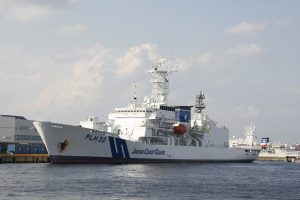The Japan Coast Guard (JCG) has announced that it plans to build its largest ever patrol vessel to improve capabilities to cope with disasters and other emergency situations.
The new ship will be around 200 meters long and will weigh about 30,000 tons. By contrast, the coast guard’s existing biggest patrol ship is 150 meters long and weighs 6,500 tons.
It has requested 3.43 billion Japanese yen ($233.6 million) in the next fiscal year 2025 budget to fund the initial costs to construct the new vessel. The total construction cost will be about 68 billion yen, a spokesperson told The Diplomat on September 2.
The new patrol boat will be an ultra-large multipurpose patrol vessel that can respond to natural disasters, terrorism against nuclear power plants, illegal fishing by numerous foreign fishing boats, and large-scale disasters including evacuation of residents, according to the JCG.
It will have enough room to transport over 1,000 people in times of emergency, as well as space to park large vehicles such as trucks and buses. It will also be able to store up to three helicopters and operate two at the same time.
It will not be equipped with weapons such as a deck-mounted machine gun. It is expected to function primarily as an “offshore base” that will serve as a security hub.
The new JCG vessel is scheduled to be commissioned in fiscal year 2029.
The plan came as the Japanese government is rushing to develop a plan for evacuating more than 100,000 Okinawans in the Sakishima Islands, located at the southernmost end of the Japanese archipelago, to the Kyushu region as well as to Japan’s main Honshu island.
The vessel is expected to protect Japanese citizens on remote islands in the event of a military emergency in Taiwan or a contingency involving the disputed Senkaku/Diaoyu Islands, which Japan administers but China claims – or both emergencies happening at the same time.
More than a few experts have expressed worries about whether Japan has sufficient maritime transportation capacity to evacuate Japanese and foreigners in Taiwan to Japan as well as maritime security capabilities to protect that maritime transportation.
On August 20, in an interview with Nikkei, Japan’s Defense Minister Kihara Minoru touched on the lessons that Russia’s invasion of Ukraine has taught Japan.
“The lesson Japan learned is that stockpiling ammunition and energy, as well as securing transportation, will be crucial to maintaining a war footing during emergencies,” he said.
There is a big difference in capabilities between the Chinese and Japanese coast guards. According to data compiled by the JCG, the China Coast Guard has 159 vessels that weigh over 1,000 tons, while the JCG has only 75, less than half the number of China’s.
Demonstrations by Chinese coast guard vessels sailing around the Senkaku Islands have become commonplace. There have been 33 intrusions into Japanese territorial waters by Chinese vessels this year as of September 2. This is almost the same as the 34 intrusions in the whole of last year. In May of this year, the number of consecutive days that Chinese vessels sailed into the contiguous zone outside of Japanese territorial waters reached the longest streak since the Senkaku Islands were nationalized by the Japanese government in September 2012.

































